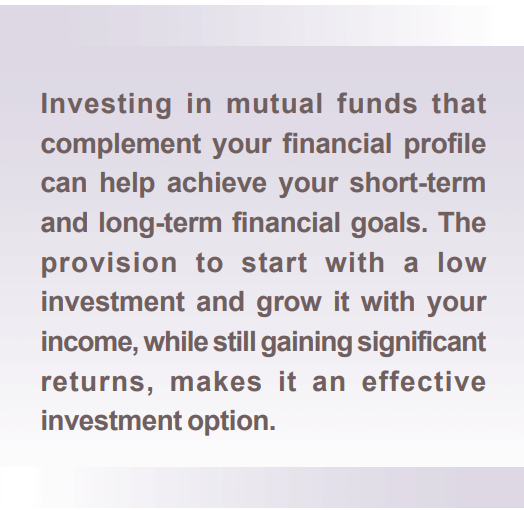Mutual funds help you compound and diversify your investments, even when starting with minimum investments. Investing in mutual funds that complement your financial profile can help achieve your short-term and long-term financial goals. The provision to start with a low investment and grow it with your income, while still gaining significant returns, makes it an effective investment option.
While choosing the right mutual funds for investment it is important to understand the difference between equity and debt mutual funds. Equity funds invest in company shares and securities, making it a high-risk and high-return investment. On the other hand, debt funds invest in fixed-income instruments like corporate and government bonds that have low to moderate risk brackets.
Compounding has been rightfully called an eighth wonder and compounded returns of equity mutual funds have helped individuals build wealth over time.
But how do you build a mutual fund portfolio from scratch as a beginner? Here is a step-by-step guide.
Step 1: List down your goals
Your financial journey begins with a clear understanding of your goals. What are you investing for? Is it a dream home, education, retirement, or something else? Your goals guide your investment journey, shaping your decisions and determining your investment horizon. Long-term goals allow for a higher risk tolerance, while short-term goals call for a more conservative approach.
Step 2: Research for investment options
Once you’ve defined your financial goals, the next step is to choose the asset class aligned with those objectives. You can choose the right mutual fund scheme by comparing equity and debt mutual funds depending on your risk appetite. For short to medium-term goals (one to three years), consider short to medium-duration Debt Funds. Equity investments are better suited for long-term goals, typically with a horizon of five to seven years or more.

Index funds can be a great starting point for beginners, providing an opportunity for competitive returns. Unlike active funds, index funds replicate their underlying index’s performance, offering competitive returns. Opting for index funds can also help you save up on management fees.
Step 3: Embrace Diversification
Diversification is a cornerstone of a sound investment strategy. After identifying your goals and suitable asset classes, diversify your investments across these classes. It helps mitigate portfolio volatility while maintaining healthy returns. Suppose you have a 10–12-year horizon to collect corpus for your child’s education, consider an allocation that includes equity (60%), debt (30%), and even gold (10%).
Enhance diversification not just across asset classes but also within the same class by investing in large-cap, mid-cap, and small-cap funds within your equity portfolio, potentially boosting returns over the long term.
Step 4: Embrace Systematic Investment Plans (SIPs)
If lack of experience concerns you to start big, SIPs give you the option to start with small investments. SIPs offer a disciplined approach with fixed investments in regular intervals and mitigating risks, helping you overcome the fear of market volatility. Start with small SIPs and gradually increase your investment as you gain confidence, harnessing the power of Rupee cost averaging. This approach is particularly suitable for long-term equity investments.
Step 5: Consider regular review and rebalancing
Successful portfolio management requires timely review and rebalancing. Conduct a review at least once a year, revisiting your asset allocation and assessing the performance of active funds in your portfolio. Eliminating low-return funds aligns your investments with your desired asset allocation, and replacing underperforming funds with better alternatives can enhance your overall returns.
Step 6: Discipline and Long-term Commitment
Gaining compounding returns from mutual fund investments boils down to creating a plan and staying consistent with it. Avoid making impulsive decisions based on short-term market fluctuations and pay your SIPs timely. Historical data demonstrates the potential for higher returns over the long haul, rewarding patient investors.
How to build a mutual fund with index funds?
Building a portfolio using index funds offers a passive investment approach, relying on market growth for long-term returns. Unlike actively managed portfolios, index funds minimise stress and expenses while mirroring specific market indices.
With diverse choices, including Indian equities, international equities, debt, commodities, smart-beta funds, and multi-asset funds, investors can create a well-rounded portfolio. Index funds provide simplicity, liquidity, and the potential for consistent returns. Using the SIP route allows automated, monthly investments, making the process accessible and convenient.
Why is it essential to consider the expense ratio?
Expense ratio is an annual charge to the Asset Management Company (AMC) for managing your funds. These charges are expressed as a percentage of assets, including the fund manager’s fee, legal/audit costs, and marketing/distribution fees. For example, investing Rs 5,000 with a 2% expense ratio will deduct 0.0054% from your assets daily. The formula used to calculate this is: Total Expenses/Average AUM (Asset Under Management)
Mutual funds with a higher expense ratio experience lower returns, making funds with lower expense ratios the ideal choice for your investments. However, it is also important to compare the overall aspects and align your goals with the funds before blindly opting for the lowest expense ratio so they fit into your long-term expectations.
In conclusion, building a mutual fund portfolio is a systematic process requiring careful consideration, discipline, and long-term commitment. Regularly revisit the steps outlined in this guide to ensure your portfolio remains aligned with your goals.
If you need professional assistance, Geojit is your ideal partner. With 37 years of market experience, Geojit provides insights, recommends portfolios based on your goals and risk profile, and helps you rebalance your portfolio for optimal returns and a financially secure future. To start investing you may visit Funds Genie, Geojit’s exclusive MF app.






